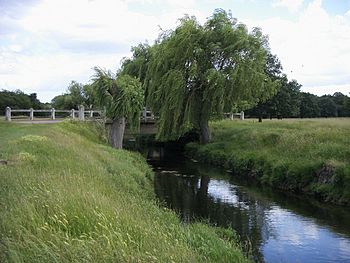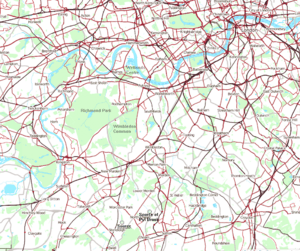Beverley Brook facts for kids
Quick facts for kids Beverley Brook |
|
|---|---|

Beverley Brook in Richmond Park
|
|

Map of the Beverley and Pyl Brooks showing surrounding parkland and access from settlements
|
|
| Country | United Kingdom |
| Physical characteristics | |
| Main source | Cuddington Recreation Park, Worcester Park, Greater London |
| River mouth | Barn Elms, River Thames 51°28′18.48″N 0°13′22.8″W / 51.4718000°N 0.223000°W |
| Length | 14.3 km (8.9 mi) |
| Basin features | |
| Tributaries |
|
The Beverley Brook is a small river in southwest London, England. It is about 14.3 km (8.9 mi) long. The river starts in Worcester Park and flows north. It eventually joins the famous River Thames near Putney Embankment at Barn Elms.
Contents
Where Does Beverley Brook Flow?
The Beverley Brook begins its journey in a shady spot. This is at Cuddington Recreation Ground in Worcester Park. From there, it flows underground for a bit. It goes through a culvert (a tunnel for water) under the A2043 road.
The Brook's Path Through London
After emerging, the brook flows northeast. It passes through areas like Motspur Park and New Malden. A big part of its journey is through Wimbledon Common and Richmond Park. In Richmond Park, you can follow paths like the Tamsin Trail next to it.
The brook then forms a short border between East Sheen and Roehampton. Finally, it flows through the south of Barnes. It joins the River Thames between Barn Elms and Leader's Gardens in Putney.
What is a Drainage Basin?
The area of land that collects rainwater for a river is called its drainage basin. For Beverley Brook, this area covers about 64 km2 (25 sq mi). All the rain that falls in this space eventually flows into the brook.
Why is the Beverley Brook Important?
The Beverley Brook is important for many reasons. It creates a natural water source for wildlife. In Richmond Park, deer and smaller animals use the water. You can also see water plants like water lilies growing there.
A Natural Boundary
For about 7 km (4.3 mi) upstream from Richmond Park, the brook acts as a historic boundary. It marks the line between the London Borough of Merton and the Royal Borough of Kingston upon Thames.
Wildlife and Nature Reserves
A large road, the A3 trunk road, runs close to the stream for about 5 km (3.1 mi). Even though you can't always see the stream from the road, you can spot the bridges. The area around the brook, especially in Wimbledon Common, is very special. It is a Site of Special Scientific Interest (SSSI). This means it's protected for its wildlife and natural features. It's also a Special Area of Conservation (SAC).
Near the southern end of Wimbledon Common, there is a nature reserve. It's called Fishpond Wood and Beverley Meads. This reserve is just a short distance east of the stream.
What Does "Beverley" Mean?
The name "Beverley" comes from a long time ago. It tells us about an animal that used to live in the river. This animal was the European beaver (Castor fiber). Beavers were common in Britain until the 1500s.
The word "bever" was the Middle English word for beaver. "Ley" (or "lea") meant meadow. And "brook" still means a small stream today. So, Beverley Brook means "Beaver-Meadow Stream."
What Are the Tributaries of Beverley Brook?
A tributary is a smaller stream or river that flows into a larger one. Beverley Brook has several tributaries.
The longest tributary is Pyl Brook. It is about 5.3 km (3.3 mi) long. Pyl Brook is so important that it is a Local Nature Reserve. It flows from Sutton through Lower Morden. It then joins Beverley Brook at Beverley Park in New Malden. Both Beverley Brook and Pyl Brook are watched by the Environment Agency. This is because they can sometimes cause flooding.
How Has the Brook Been Improved?
For many years, the Beverley Brook had problems with pollution. This was due to poorly treated sewage. However, things changed in 1998. The sewage works were removed, and better treatment methods were put in place. Since then, more types of wildlife have started to live in the river. This shows that the water quality has improved a lot.
At Wimbledon Common, the banks of Beverley Brook have wooden supports. These supports help prevent erosion. However, they also make it harder for animals like water voles to use the banks. There is still work that can be done to make the brook even better for wildlife.
Beverley Brook in Stories
Beverley Brook is not just a real river. She is also a character in a series of fantasy books. These books are called Rivers of London by Ben Aaronovitch. In the stories, Beverley Brook is a powerful spirit of the river. She is one of the "Orisa," who are like ancient river gods.
Images for kids





